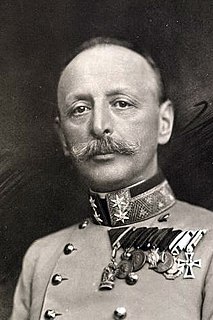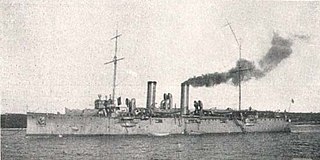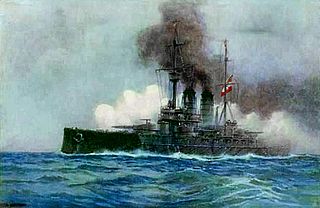
SMS Zrínyi was a Radetzky-class pre-dreadnought battleship (Schlachtschiff) of the Austro-Hungarian Navy, named for the Zrinski, a noble Croatian family. Zrínyi and her sisters, Erzherzog Franz Ferdinand and Radetzky, were the last pre-dreadnoughts built for the Austro-Hungarian Navy.

Lovćen is a mountain and national park in southwestern Montenegro. It is the inspiration behind the name of Montenegro; Crna Gora, was first mentioned in a charter issued by Stefan Milutin in 1276, the name Montenegro deriving from the appearance of Mount Lovćen when covered in dense forests.

The Battle of Mojkovac was a World War I battle fought between 6 January and 7 January 1916 near Mojkovac, in today's Montenegro, between the armies of Austria-Hungary and the Kingdom of Montenegro. It ended with a Montenegrin Pyrrhic victory.

The Radetzky class was a group of three semi-dreadnought battleships built for the Austro-Hungarian Navy between 1907 and 1910. All ships were built by the STT shipyard in Trieste. They were the last pre-dreadnoughts built by the Austro-Hungarians, and the penultimate class of any type of Austro-Hungarian battleship completed. The class comprised three ships: Radetzky, Erzherzog Franz Ferdinand, and Zrínyi. They were armed with four 30.5-centimeter (12.0 in) guns in two twin turrets and eight 24 cm (9.4 in) guns in four twin turrets; the heavy secondary guns set the Radetzky-class ships apart from other pre-dreadnought type battleships.

Stjepan Freiherr Sarkotić von Lovćen was an Austro-Hungarian Army lieutenant field marshal who served as Governor of Bosnia and Herzegovina and military commander of Dalmatia and Montenegro during the World War I.

The Adriatic Campaign of World War I was a naval campaign fought between the Central Powers and the Mediterranean squadrons of Great Britain, France, the Kingdom of Italy, Australia and the United States.

SMS Radetzky was the first of the three Radetzky-class pre-dreadnought battleships built for the Austro-Hungarian Navy. She was named for the 19th century Austrian Field Marshal Joseph Radetzky von Radetz. Radetzky and her sisters, Erzherzog Franz Ferdinand and Zrínyi, were the last pre-dreadnoughts built by the Austro-Hungarian Navy—they were followed by the larger and significantly more powerful Tegetthoff-class dreadnoughts.

The Battle of Antivari or Action off Antivari was a naval engagement between the mainly French, British and two small ships of the Austro-Hungarian navy at the start of World War I. The old Austrian protected cruiser SMS Zenta and the destroyer SMS Ulan were blockading the Montenegrin port of Antivari, when on 16 August 1914 they were surprised and cut off by a large Anglo-French force that had sortied into the Adriatic. The Austrian warships were forced to fight an engagement in an attempt to let the destroyer escape. Although Zenta was destroyed, Ulan escaped and those ships of the Austrian fleet which were at Cattaro, unaware of events, did not come out of port to meet the Allied fleet. After blockading the Adriatic for a short while the French were forced to withdraw due to lack of supplies.

SMS Erzherzog Franz Ferdinand was an Austro-Hungarian Radetzky-class pre-dreadnought battleship commissioned into the Austro-Hungarian Navy on 5 June 1910. She was named after Archduke Franz Ferdinand. The first ship of her class to be built, she preceded Radetzky by more than six months. Her armament included four 30.5 cm (12 in) guns in two twin turrets, and eight 24 cm (9.4 in) guns in four twin turrets.

The Monarch class was a class of three coastal defence ships, built by Austria-Hungary at the end of the 19th century. The Monarchs were the first ships of their type to utilize turrets. The class comprised three ships: SMS Monarch, SMS Wien, and SMS Budapest, each armed with four 240 mm (9 in) L/40 guns in two turrets and capable of 15.5 knots at full speed. Budapest was fitted with slightly more modern and powerful engines, giving her a top speed of 17.5 knots.

SMS Wien was one of three Monarch-class coastal defense ships built for the Austro-Hungarian Navy in the 1890s. After her commissioning, the ship participated in an international blockade of Crete during the Greco-Turkish War of 1897. Wien and the two other Monarch-class ships made several training cruises in the Mediterranean Sea in the early 1900s. They formed the 1st Capital Ship Division of the Austro-Hungarian Navy until they were replaced by the newly commissioned Habsburg-class predreadnought battleships at the turn of the century. In 1906 the three Monarchs were placed in reserve and only recommissioned for annual summer training exercises. After the start of World War I, Wien was recommissioned and assigned to 5th Division together with her sisters.

SMS Kaiser Karl VI was the second of three armored cruisers built by the Austro-Hungarian Navy. She was built by the Stabilimento Tecnico Triestino in Trieste between June 1896 and May 1900, when she was commissioned into the fleet. Kaiser Karl VI represented a significant improvement over the preceding design—Kaiserin und Königin Maria Theresia—being faster and more heavily armed and armored. She provided the basis for the third design, Sankt Georg, which featured further incremental improvements. Having no overseas colonies to patrol, Austria-Hungary built the ship solely to reinforce its battle fleet.
In the aftermath of the First World War, the Adriatic Question or Adriatic Problem concerned the fate of the territories along the eastern coast of the Adriatic Sea that formerly belonged to the Austro-Hungarian Empire. The roots of the dispute lay in the secret Treaty of London, signed during the war, and in growing nationalism, especially Italian irredentism and Yugoslavism, which led ultimately to the creation of Yugoslavia. The question was a major barrier to agreement at the Paris Peace Conference, but was partially resolved by the Treaty of Rapallo between Italy and Yugoslavia on 12 November 1920.

SMS Monarch was the lead ship of the Monarch-class coastal defense ship built for the Austro-Hungarian Navy in the 1890s. After their commissioning, Monarch and the two other Monarch-class ships made several training cruises in the Mediterranean Sea in the early 1900s. Monarch and her sisters formed the 1st Capital Ship Division of the Austro-Hungarian Navy until they were replaced by the newly commissioned Habsburg-class pre-dreadnought battleships at the turn of the century. In 1906 the three Monarchs were placed in reserve and only recommissioned during the annual summer training exercises. After the start of World War I, Budapest was recommissioned and assigned to 5th Division together with her sisters.

Fort Vrmac is a former fortification of the Austro-Hungarian Empire located on the southern end of the Vrmac ridge near Tivat in Montenegro. Established in 1860, the present structure was built between 1894 and 1897, and saw action during the First World War, when it was heavily bombarded by the Montenegrins. It was repaired and disarmed before the end of the war and was abandoned after a period of occupation by Yugoslav troops. Today it is one of the best preserved Austro-Hungarian fortifications in the Bay of Kotor area.

Fort Gorazda is a fortification built by the Austro-Hungarian Empire near Kotor in Montenegro. The current fort was built between 1884–86 and replaced an earlier structure on the same site; its most notable feature is a 100-ton Gruson rotating turret on its roof, the last remaining example of its type. The fort was used by the Austrians in artillery duels against Montenegrin batteries stationed on Mount Lovćen during the First World War. The Montenegrins were unable to destroy it and were pushed out of range in 1916 by an Austrian offensive. The damage to the fort was repaired and its guns were removed to support the Austrian field army. It was used as a depot by the Yugoslav Army until as recently as the early 1990s. It was subsequently abandoned and can be visited by the public.
The Škoda 7 cm K10 was a dual-purpose gun of the Austro-Hungarian Empire that was used by the Austro-Hungarian Navy during World War I. The gun was actually 66 mm, but the classification system for artillery rounded up to the next highest centimeter. The 7 cm K10 was also used by the Italian Navy on ships ceded as war reparations and as coastal artillery during World War II. The Italians referred to it as the 66/47.

The Kaiser Franz Joseph I class was a class of two protected cruisers built for the Austro-Hungarian Navy. Named for Austro-Hungarian Emperor Franz Joseph I, the class comprised SMS Kaiser Franz Joseph I and SMS Kaiserin Elisabeth. Construction took place throughout the late 1880s, with both ships being laid down in 1888. Kaiser Franz Joseph I was built by Stabilimento Tecnico Triestino in Trieste, while Kaiserin Elisabeth was built at the Pola Navy Yard in Pola. The Kaiser Franz Joseph I-class ships were the first protected cruisers constructed by the Austro-Hungarian Navy. Kaiser Franz Joseph I was the first ship of the class to be commissioned into the fleet in July 1890. She was followed by Kaiserin Elisabeth in November 1892.

SMS Kaiser Franz Joseph I was a protected cruiser built for the Austro-Hungarian Navy. Named for the Austrian emperor and Hungarian king Franz Joseph I, Kaiser Franz Joseph I was the lead ship of her namesake class. Constructed by Stabilimento Tecnico Triestino in Trieste, she was laid down in January 1888 and launched in May 1889. Kaiser Franz Joseph I was commissioned into the Navy in June 1890. As the first protected cruiser constructed by the Austro-Hungarian Navy, she was intended to serve as Austria-Hungary's response to the Italian cruisers Giovanni Bausan and Etna. Her design was heavily influenced by the Jeune École, a naval strategy which had gained prominence in the 1880s as a means to combat a larger and more heavily armored navy of battleships through the use of torpedo flotillas.
















